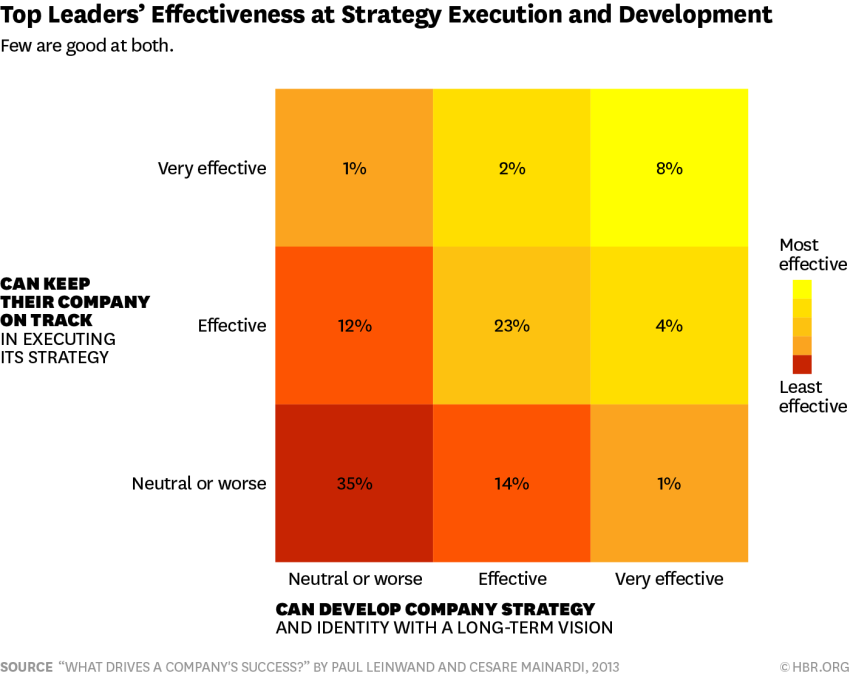 By Travis Barker, Consulting Partner at Stellar
By Travis Barker, Consulting Partner at Stellar
I love this quote from Peter Drucker. It describes perfectly the strategy execution paradox that challenges almost every organisation – that of aligning action with strategic intent.
At Stellar, we’ve been doing a bunch of strategic consulting work recently across a variety of industries and organisations: big, small, public, private, high growth start-up, established market leaders. And, by and large, our customers do a great job in defining their unique value propositions and business strategies.
However, if there is one universally binding characteristic for companies at all levels and stages of growth, it is their ability (or perhaps more correctly, their inability) to align ‘strategy’ (the bigger-picture vision of where the company is headed) and ‘execution’ (the day-to-day tasks that get it there).
Take a look at this article from Harvard Business Review, depressingly called “Only 8% of Leaders are Good at Strategy and Execution,” and pay particular attention to this graphic emphasising that:

There are four times as many leaders considered “neutral or worse” at the intersection of strategy and execution (35%) as opposed to those considered “very effective” (8%) at both.
This is obviously a large problem for organisations – this particular study was done in 2013 with 700+ companies across a variety of industries, for background context – and it bears itself out in other ways too.
Consider this research from MIT’s Sloan School of Management: it studied 11,000 managers at companies across the globe and found that 67 percent of them couldn’t name their firm’s top priorities. Some of these managers reported directly to the CEO, meaning they probably sat in the meetings defining the priorities – and yet, still couldn’t name them. As the article linked above states:
When asked, only a third of senior managers could correctly identify what the CEO had identified as the firm’s top three priorities. “When you drop one or two levels below the CEO, your ability to form a holistic picture is simply lost,” she says. In this vacuum, “you’re leaving managers across the organisation to prioritise by themselves.”
If you take these two bits of research together, we have a major problem in organisations. Here’s how it looks:
- Most decision-makers can’t align strategy and execution
- Many decision-makers can’t prioritise goals either
This creates a vacuum where middle managers can essentially create priorities for their direct reports, which leads to an excess of shallow work (logistical, task-based). That won’t drive your organisation forward in any type of growth or revenue sense.
Any effective business begins with alignment, notably around these areas:
- Alignment of company goals (typically set by executives) with individual goals of those who must execute on the company goals (rank-and-file to middle workers)
- Alignment of work tasks with legitimate company priority
- Alignment of managers/those who can assign work to others with company priority and strategy
Those three tiers of alignment need to be in place for any company to drive forward successfully – and use their resources, both human and physical, in the smartest possible ways.
Unfortunately, many companies have some small percentage of these three bullets actually aligned and end up running in circles on some of the others.
You’re looking to turn strategic intent into tangible action – and that’s what we do at Stellar. We use the power of data and technology to align organisational execution with strategy – otherwise known as Business Intelligence.
So here’s the question: If your organisation is making money and hitting quarterly targets, why should you care about alignment? You’re obviously successful and fulfilling a customer need.
The short answer is ‘digital disruption.’ The long answer is more nuanced, and we’ll deal with it in another blog post. But for now, suffice to say it’s coming your way, like it or not!
I recently attended an Institute of Directors’ breakfast seminar with Chris Liddell – former CFO of Microsoft and GM among other things – and in between sharing his candid views on the 2016 US presidential election and discussing the emergence of institutional philanthropy in New Zealand, Chris touched on the stark reality facing every organisation today – the need to embrace digital or die. Or in his words: “There’s not a single business model that won’t be disrupted by the digital revolution.”
Look at some of this research on the necessity of change management, which ties into revenue growth too. One of the key aspects to note is that 4-5 in 10 of established companies globally are potential candidates to be disrupted by a well-funded alternative within their market.
Disruption can come for anyone, and disruption starts really spinning out of control and hurting your market share when you have unclear priorities, lack of tangible action, and knowledge (i.e. people) fleeing for the exits because of managerial issues. You need to prevent all those from occurring, and you prevent them by starting to align action with strategy.
That’s where we come in. Contact Stellar to learn more.




